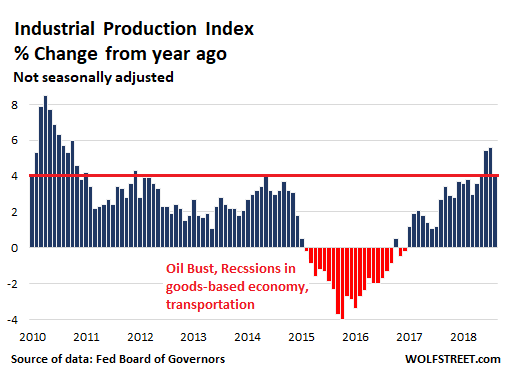How US Oil Booms & Busts Hit Industrial Production
Fueled by cheap money and by dashed hopes of high oil prices.
Industrial production in October rose 4.1% from a year ago, the Fed Board of Governors reported this morning. This was in the upper portion of the range since 2010. It was powered in part by the blistering oil & gas production boom that followed the Oil Bust of 2015 and 2016.
This chart shows the percent change in industrial production from the same month a year earlier. The red bars – industrial production falling year-over-year – coincide with the recession in the goods-based economy, the transportation recession, and the Oil Bust:

As part of the overall index, manufacturing rose 2.7% from a year ago, utilities 1.7%, and mining, which includes oil & gas extraction, jumped 13.1%. Oil & gas extraction on its own soared 16.5% from a year ago.
On a monthly basis oil & gas extraction edged down a smidgen over the past two months from a spikey record in August, when it had soared 22.9% year-over-year.
The chart below shows the Industrial Production sub-index for crude oil and natural gas extraction. Note the brief effects of Hurricane Katrina when production along the Gulf Coast was shut down, the Financial Crisis when everything came to a standstill, the subsequent fracking boom, the oil bust in 2015 and 2016, and then the renewed boom. Since the trough of the oil bust in September 2016, the index has surged 31.5%:

It has been a wild ride in the oil & gas sector. At the end of 2008 – following the Lehman Moment – everything came to a halt for a couple of months, but then activity rebounded. Starting in 2011, the fracking boom, fueled by waves of new money trying to find a place to go, took off. At the time, oil prices (WTI) ranged from $75 to $113 a barrel. But in July 2014, oil prices began to dive, and in 2015, the oil bust hit production.
…click on the above link to read the rest of the article…